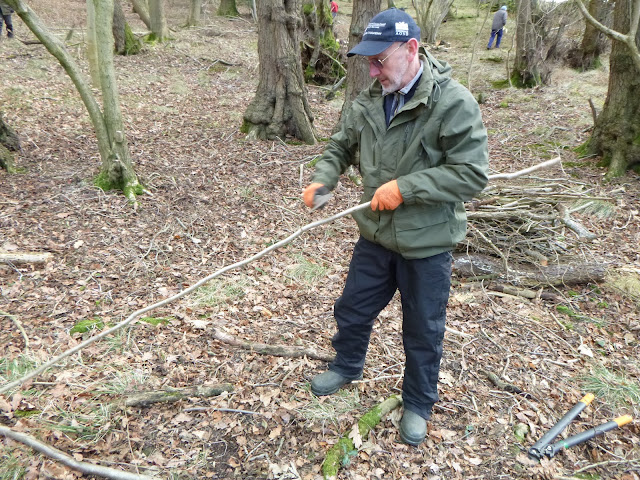Coppice training - an antidote to a Brexit vote.
Whilst MPs went off to the Houses of Parliament yesterday to vote on the future of our country, there was a much nicer prospect for the NCVs. They revisited the Summerbridge nature reserve to find out how to coppice hazel. The trainer was Geoff Norton of Yorkshire hurdles . The photos below show the processes involved and the NCVs' progress.
The reserve's herd of lovely Belted Galloway cows and their calves
ran down the hill to listen to Geoff's talk.
However - it turned out that they were more interested in nibbling his truck.
One important thing that had to be done was to protect as many of the cut stools as possible from the ravages of the local deer population. The best way to do this was to utilise all the remaining brash to construct high barriers - a bit like giant birds' nests.
It looks untidy but does the job.
He also demonstrated how to sharpen the end of a rod to use as either a hedging post or a 'zaile' (one of the two end posts that make the frame for a woven hurdle).
You need to make the point as long as possible.
First up, Geoff gave the group a little talk about his job,
coppicing and the tools of the trade.
The reserve's herd of lovely Belted Galloway cows and their calves
ran down the hill to listen to Geoff's talk.
However - it turned out that they were more interested in nibbling his truck.
Next Geoff chose a hazel stool to demonstrate on.
Please note that this kind of hazel stool is not something you buy in IKEA.
It refers to the main tree stump that all the stems grow from.
Then, chain saw in hand, he was off - removing each of the stems as low as he could
get. Stems can be put to different uses depending on their size and straightness.
get. Stems can be put to different uses depending on their size and straightness.
Some can be used for bean poles, hurdle weaving, hedge laying posts
and ties, pea sticks, charcoal and fire wood.
Once finished there wasn't much left but the stool..
However - this summer new stems will start sprouting up.
Geoff spared just one stem in order to show us how to layer it.
Basically this means bending it over, pegging it down into the soil and
leaving it for a couple of years to root and form a new plant.
Finally it was our turn to have a go. Working in pairs we chose a stool and got busy.
Of course - we had to use loppers and bow saws - no chain saws for us!
Well done Anita!
You can leave that last one to Geoff and his chain saw.
All over the woodland pairs of NCVs were on their knees, sawing for England.
Nice two handed saw work lads!
Of course sawing through all these stems generated
oceans of cuttings that needed gathering up and processing.
Yes - that looks a bit more sorted Graham.
Yes - that looks a bit more sorted Graham.
That's a neat habitat pile Tom.
Eventually Geoff demonstrated how to process the useful cut stems
(as opposed to the firewood and brash). Using a bill hook he:
a) 'threaded a rod' (took off any sticky out bits)
b) 'snedded a pole' (same thing only BIGGER)
One important thing that had to be done was to protect as many of the cut stools as possible from the ravages of the local deer population. The best way to do this was to utilise all the remaining brash to construct high barriers - a bit like giant birds' nests.
It looks untidy but does the job.
Finally it was back to Geoff's truck for a quick lesson on tying bundling knots...
...to ensure that bundles of rods dry straight and are easier to move around.
...to ensure that bundles of rods dry straight and are easier to move around.
He also demonstrated how to sharpen the end of a rod to use as either a hedging post or a 'zaile' (one of the two end posts that make the frame for a woven hurdle).
You need to make the point as long as possible.























No comments:
Post a Comment